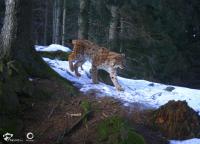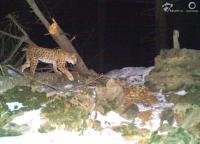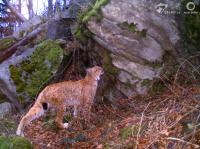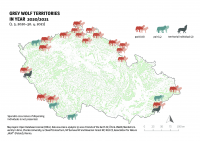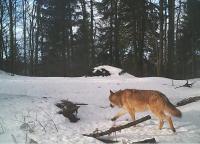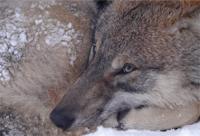THE SAVEGREEN PROJECT HELPS TO PROTECT LARGE CARNIVORES IN BESKYDY
The Beskydy Mountains are the last place in the Czech Republic with the regular presence of all three species of European large carnivores. Here as in the whole Carpathians, the carnivore populations are under severe threat from landscape fragmentation due to their large space demands and the need to move over long distances. That is why we talked about the need to preserve ecological corridors at the SaveGREEN information day that took place in Beskydy on the Czech-Slovak-Polish border where large carnivores from all three countries meet.
CONSTRUCTION IN THE ECOLOGICAL CORRIDOR IN SLOVAKIA THREATENS PROTECTED CARNIVORE POPULATIONS IN THE BESKYDY MOUNTAINS
A large private building covering a floor space of more than 1,600 m2 is to be built in the ecological corridor of large mammals in the Visolaje municipal area. The location is close to the Natura 2000 sites declared, among other objectives, for the protection of large carnivores such as wolves, lynx, and bears. Preserving the remaining wildlife corridors between the mountain ranges is essential for the survival of these species on the Czech-Slovak border. Construction in the large mammal ecological corridor could threaten the Beskydy population of large carnivores. As the Trenčín district office has ruled out any impact on the Natura 2000 area, the Hnutí DUHA Šelmy (Friends of the Earth Czech Republic – Large Carnivore Conservation Programme) is asking for a cross-border assessment of the project and its impact on critically endangered animals.
Outcomes of the lynx telemetry monitoring in the Beskydy Mountains
More than a year of GPS tracking of five male lynx in the Beskydy Mountains has yielded the first results. Researchers from Mendel University have mapped what routes lynx use to move around. Telemetry monitoring also showed which sections are critical in terms of connectivity for large carnivores and need to be specially protected.
NO MORE UNSOLVED CASES. POACHING OF LARGE CARNIVORES WILL BE A MATTER FOR SPECIALLY TRAINED POLICE INVESTIGATORS
So far, there has been very little success in addressing the illegal hunting of wolves and lynx in the Czech Republic. Often, it is not the investigators who are to blame but the lack of resources, equipment and experience with this type of crime. That is why the large carnivore experts of Hnutí DUHA (Friends of the Earth Czech Republic) propose the formation of a special unit within the Czech police force that will systematically deal with wildlife crime, including illegal hunting of large carnivores. It should be a team of experienced criminologists cooperating with other experts. A special unit with a nationwide scope of operation would not only help to prevent the poaching of large carnivores but would also relieve overburdened local police officers.
RESEARCH REVEALS A HIGH TURNOVER AND LOW SURVIVAL RATE OF LYNX IN THE WESTERN CARPATHIANS
Extensive research on the lynx population at the periphery of the Western Carpathians was conducted between 2015 and 2020 by an international team of scientists, including Hnutí DUHA zoologists and fieldworkers. The team led by Martin Dula from the Institute of Forest Ecology at Mendel University in Brno focused on evaluating population trends and published their findings in spring 2021 in the prestigious scientific journal Scientific Reports.
The annual wolf monitoring confirms two new wolf territories in the Czech Republic
In 2021, the unique field monitoring of large carnivores identified twenty-four wolf territories that at least partially extended into the Czech Republic. That is two more territories compared to the data from the 2019–2020 season; one in the Orlické Mountains and one in the Upper Palatine Forest [1]. Most of the territories were located in border areas of Bohemia (the western part of the Czech Republic), some reaching the Czech Republic only by margins. Eighteen areas were occupied by wolf packs, four were used by wolf pairs and in two cases by single individuals.
On the wolf track
There are several ways how we can learn about the secret life of large carnivores. In modern days, we use technology such as camera traps; we collect scat samples for genetic and diet analyses; or we can track the animal’s exact location in the mountains using GPS telemetry. But to gain any true insight into the hidden life of wolves, lynx, and bears, we must follow their footsteps – quite literally. That's why every year I cannot wait for the winter to come with snow covering the mountains.
Make a donation and support large carnivore conservation
Support the unique project of protection of lynx, wolves and bears in the Beskydy Mountains. In past centuries these carnivores were exterminated and their return needs our help. Local group of Friends of the Earth Czech Republic realize conservation activities focused on field monitoring, education of stakeholders and prevention of poaching.

.png)

